ABC Corp: International Finance Exam Solution and Analysis
VerifiedAdded on 2022/11/24
|8
|2221
|358
Homework Assignment
AI Summary
This assignment solution provides a comprehensive analysis of international finance concepts, focusing on hedging strategies for receivables and payables. It explores money market, forward, and option contract hedges, comparing their effectiveness in minimizing foreign exchange risk for a hypothetical company, ABC Corp. The solution details the calculations and steps involved in each hedging technique, including borrowing, converting currencies, and utilizing forward rates and option premiums. The analysis extends to comparing the net receivables and payables under different hedging methods, ultimately recommending the most advantageous strategy. Furthermore, the assignment delves into the importance of internal versus external hedging techniques, discussing the advantages of internal methods, such as risk sharing, and the application of these concepts to minimize foreign exchange risk. The solution also addresses the role of hedging in risk management and examines the challenges associated with corporate hedging in the foreign exchange market, including market volatility and political instability. Finally, the assignment includes an analysis of interest rate parity and arbitrage opportunities, demonstrating the application of these concepts in determining equilibrium in the foreign exchange market. The document concludes by providing a detailed example of arbitrage profit calculation.
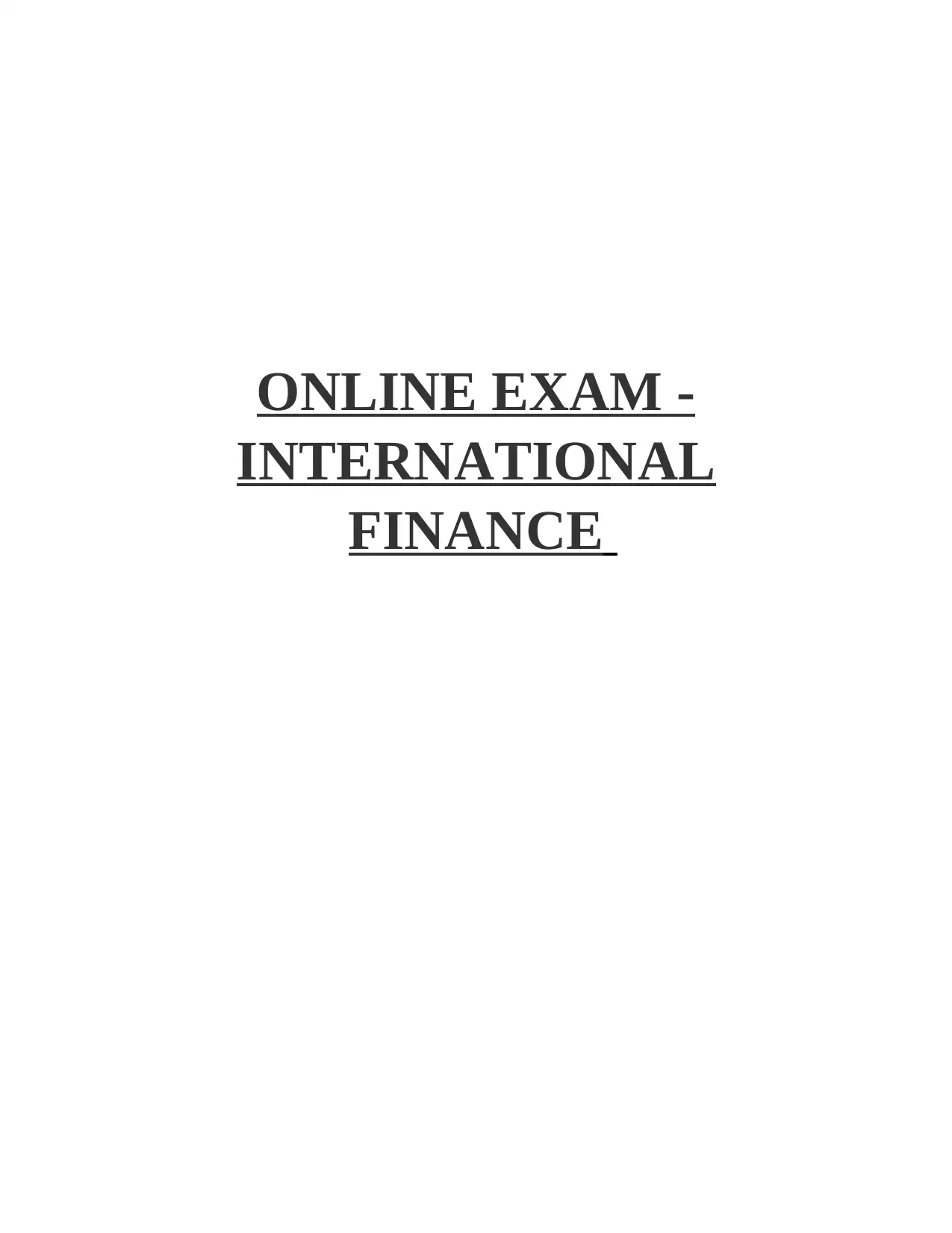
ONLINE EXAM -
INTERNATIONAL
FINANCE
INTERNATIONAL
FINANCE
Paraphrase This Document
Need a fresh take? Get an instant paraphrase of this document with our AI Paraphraser
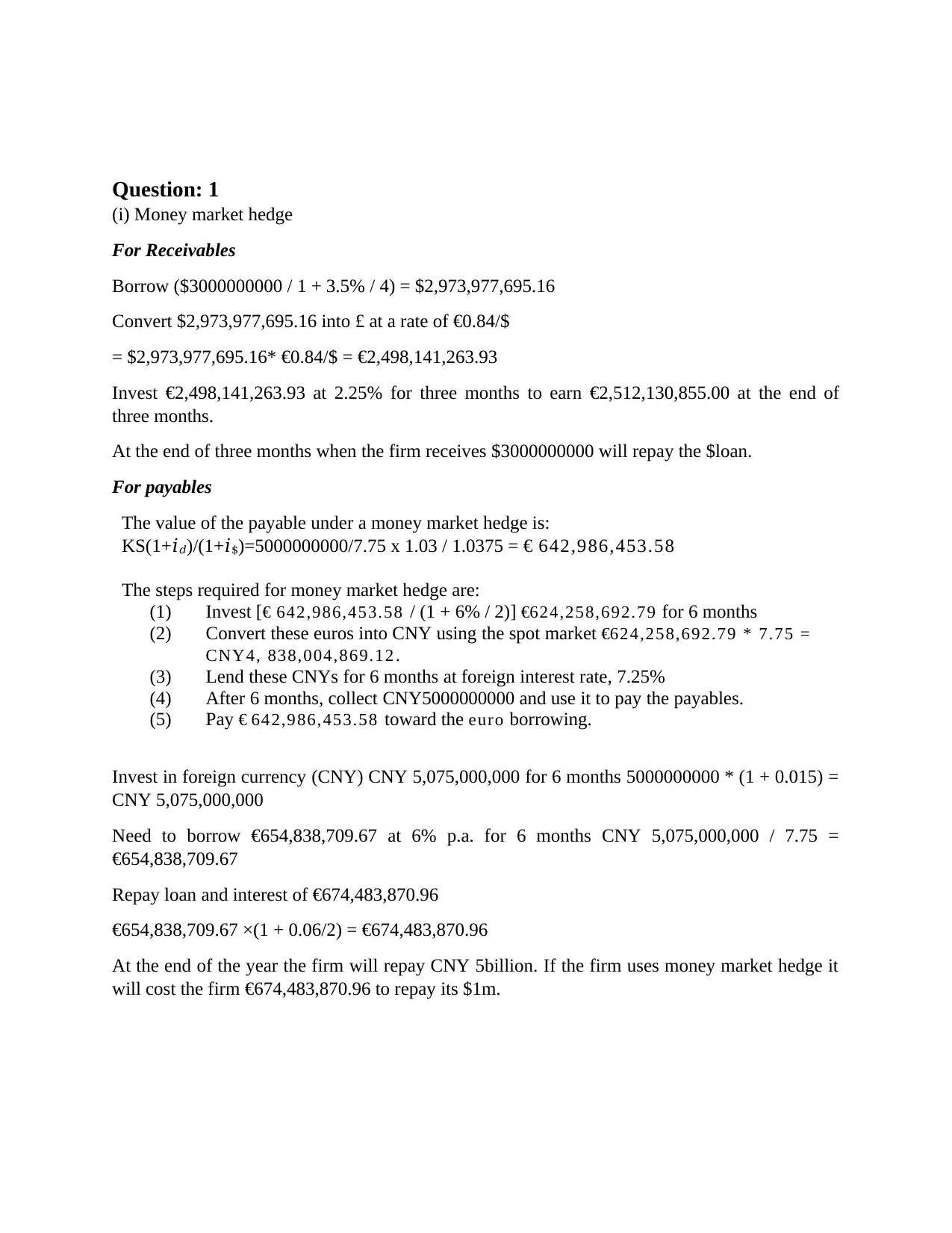
Question: 1
(i) Money market hedge
For Receivables
Borrow ($3000000000 / 1 + 3.5% / 4) = $2,973,977,695.16
Convert $2,973,977,695.16 into £ at a rate of €0.84/$
= $2,973,977,695.16* €0.84/$ = €2,498,141,263.93
Invest €2,498,141,263.93 at 2.25% for three months to earn €2,512,130,855.00 at the end of
three months.
At the end of three months when the firm receives $3000000000 will repay the $loan.
For payables
The value of the payable under a money market hedge is:
KS(1+𝑖𝑑)/(1+𝑖$)=5000000000/7.75 x 1.03 / 1.0375 = € 642,986,453.58
The steps required for money market hedge are:
(1) Invest [€ 642,986,453.58 / (1 + 6% / 2)] €624,258,692.79 for 6 months
(2) Convert these euros into CNY using the spot market €624,258,692.79 * 7.75 =
CNY4, 838,004,869.12 .
(3) Lend these CNYs for 6 months at foreign interest rate, 7.25%
(4) After 6 months, collect CNY5000000000 and use it to pay the payables.
(5) Pay € 642,986,453.58 toward the euro borrowing.
Invest in foreign currency (CNY) CNY 5,075,000,000 for 6 months 5000000000 * (1 + 0.015) =
CNY 5,075,000,000
Need to borrow €654,838,709.67 at 6% p.a. for 6 months CNY 5,075,000,000 / 7.75 =
€654,838,709.67
Repay loan and interest of €674,483,870.96
€654,838,709.67 ×(1 + 0.06/2) = €674,483,870.96
At the end of the year the firm will repay CNY 5billion. If the firm uses money market hedge it
will cost the firm €674,483,870.96 to repay its $1m.
(i) Money market hedge
For Receivables
Borrow ($3000000000 / 1 + 3.5% / 4) = $2,973,977,695.16
Convert $2,973,977,695.16 into £ at a rate of €0.84/$
= $2,973,977,695.16* €0.84/$ = €2,498,141,263.93
Invest €2,498,141,263.93 at 2.25% for three months to earn €2,512,130,855.00 at the end of
three months.
At the end of three months when the firm receives $3000000000 will repay the $loan.
For payables
The value of the payable under a money market hedge is:
KS(1+𝑖𝑑)/(1+𝑖$)=5000000000/7.75 x 1.03 / 1.0375 = € 642,986,453.58
The steps required for money market hedge are:
(1) Invest [€ 642,986,453.58 / (1 + 6% / 2)] €624,258,692.79 for 6 months
(2) Convert these euros into CNY using the spot market €624,258,692.79 * 7.75 =
CNY4, 838,004,869.12 .
(3) Lend these CNYs for 6 months at foreign interest rate, 7.25%
(4) After 6 months, collect CNY5000000000 and use it to pay the payables.
(5) Pay € 642,986,453.58 toward the euro borrowing.
Invest in foreign currency (CNY) CNY 5,075,000,000 for 6 months 5000000000 * (1 + 0.015) =
CNY 5,075,000,000
Need to borrow €654,838,709.67 at 6% p.a. for 6 months CNY 5,075,000,000 / 7.75 =
€654,838,709.67
Repay loan and interest of €674,483,870.96
€654,838,709.67 ×(1 + 0.06/2) = €674,483,870.96
At the end of the year the firm will repay CNY 5billion. If the firm uses money market hedge it
will cost the firm €674,483,870.96 to repay its $1m.
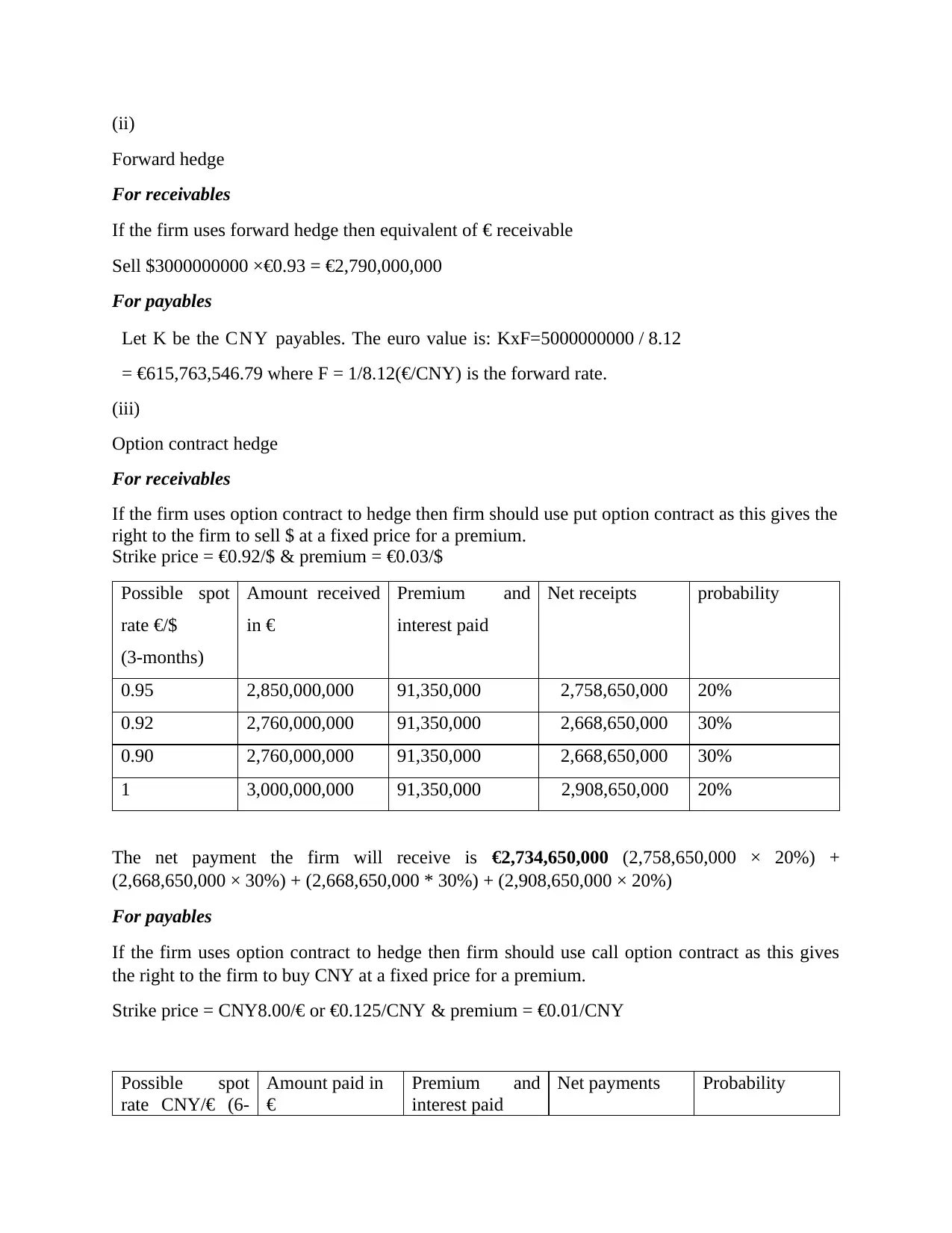
(ii)
Forward hedge
For receivables
If the firm uses forward hedge then equivalent of € receivable
Sell $3000000000 ×€0.93 = €2,790,000,000
For payables
Let K be the CNY payables. The euro value is: KxF=5000000000 / 8.12
= €615,763,546.79 where F = 1/8.12(€/CNY) is the forward rate.
(iii)
Option contract hedge
For receivables
If the firm uses option contract to hedge then firm should use put option contract as this gives the
right to the firm to sell $ at a fixed price for a premium.
Strike price = €0.92/$ & premium = €0.03/$
Possible spot
rate €/$
(3-months)
Amount received
in €
Premium and
interest paid
Net receipts probability
0.95 2,850,000,000 91,350,000 2,758,650,000 20%
0.92 2,760,000,000 91,350,000 2,668,650,000 30%
0.90 2,760,000,000 91,350,000 2,668,650,000 30%
1 3,000,000,000 91,350,000 2,908,650,000 20%
The net payment the firm will receive is €2,734,650,000 (2,758,650,000 × 20%) +
(2,668,650,000 × 30%) + (2,668,650,000 * 30%) + (2,908,650,000 × 20%)
For payables
If the firm uses option contract to hedge then firm should use call option contract as this gives
the right to the firm to buy CNY at a fixed price for a premium.
Strike price = CNY8.00/€ or €0.125/CNY & premium = €0.01/CNY
Possible spot
rate CNY/€ (6-
Amount paid in
€
Premium and
interest paid
Net payments Probability
Forward hedge
For receivables
If the firm uses forward hedge then equivalent of € receivable
Sell $3000000000 ×€0.93 = €2,790,000,000
For payables
Let K be the CNY payables. The euro value is: KxF=5000000000 / 8.12
= €615,763,546.79 where F = 1/8.12(€/CNY) is the forward rate.
(iii)
Option contract hedge
For receivables
If the firm uses option contract to hedge then firm should use put option contract as this gives the
right to the firm to sell $ at a fixed price for a premium.
Strike price = €0.92/$ & premium = €0.03/$
Possible spot
rate €/$
(3-months)
Amount received
in €
Premium and
interest paid
Net receipts probability
0.95 2,850,000,000 91,350,000 2,758,650,000 20%
0.92 2,760,000,000 91,350,000 2,668,650,000 30%
0.90 2,760,000,000 91,350,000 2,668,650,000 30%
1 3,000,000,000 91,350,000 2,908,650,000 20%
The net payment the firm will receive is €2,734,650,000 (2,758,650,000 × 20%) +
(2,668,650,000 × 30%) + (2,668,650,000 * 30%) + (2,908,650,000 × 20%)
For payables
If the firm uses option contract to hedge then firm should use call option contract as this gives
the right to the firm to buy CNY at a fixed price for a premium.
Strike price = CNY8.00/€ or €0.125/CNY & premium = €0.01/CNY
Possible spot
rate CNY/€ (6-
Amount paid in
€
Premium and
interest paid
Net payments Probability
⊘ This is a preview!⊘
Do you want full access?
Subscribe today to unlock all pages.

Trusted by 1+ million students worldwide
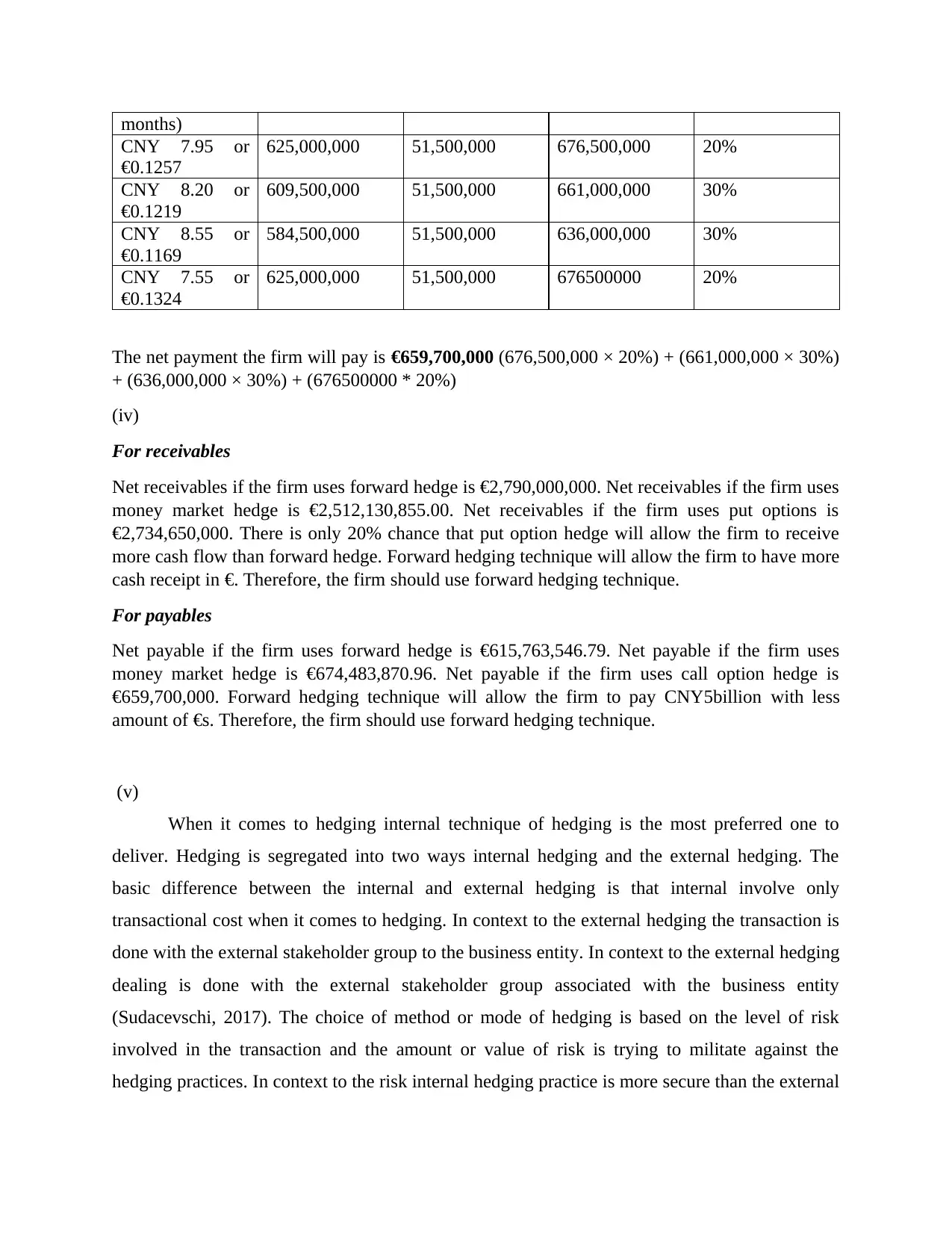
months)
CNY 7.95 or
€0.1257
625,000,000 51,500,000 676,500,000 20%
CNY 8.20 or
€0.1219
609,500,000 51,500,000 661,000,000 30%
CNY 8.55 or
€0.1169
584,500,000 51,500,000 636,000,000 30%
CNY 7.55 or
€0.1324
625,000,000 51,500,000 676500000 20%
The net payment the firm will pay is €659,700,000 (676,500,000 × 20%) + (661,000,000 × 30%)
+ (636,000,000 × 30%) + (676500000 * 20%)
(iv)
For receivables
Net receivables if the firm uses forward hedge is €2,790,000,000. Net receivables if the firm uses
money market hedge is €2,512,130,855.00. Net receivables if the firm uses put options is
€2,734,650,000. There is only 20% chance that put option hedge will allow the firm to receive
more cash flow than forward hedge. Forward hedging technique will allow the firm to have more
cash receipt in €. Therefore, the firm should use forward hedging technique.
For payables
Net payable if the firm uses forward hedge is €615,763,546.79. Net payable if the firm uses
money market hedge is €674,483,870.96. Net payable if the firm uses call option hedge is
€659,700,000. Forward hedging technique will allow the firm to pay CNY5billion with less
amount of €s. Therefore, the firm should use forward hedging technique.
(v)
When it comes to hedging internal technique of hedging is the most preferred one to
deliver. Hedging is segregated into two ways internal hedging and the external hedging. The
basic difference between the internal and external hedging is that internal involve only
transactional cost when it comes to hedging. In context to the external hedging the transaction is
done with the external stakeholder group to the business entity. In context to the external hedging
dealing is done with the external stakeholder group associated with the business entity
(Sudacevschi, 2017). The choice of method or mode of hedging is based on the level of risk
involved in the transaction and the amount or value of risk is trying to militate against the
hedging practices. In context to the risk internal hedging practice is more secure than the external
CNY 7.95 or
€0.1257
625,000,000 51,500,000 676,500,000 20%
CNY 8.20 or
€0.1219
609,500,000 51,500,000 661,000,000 30%
CNY 8.55 or
€0.1169
584,500,000 51,500,000 636,000,000 30%
CNY 7.55 or
€0.1324
625,000,000 51,500,000 676500000 20%
The net payment the firm will pay is €659,700,000 (676,500,000 × 20%) + (661,000,000 × 30%)
+ (636,000,000 × 30%) + (676500000 * 20%)
(iv)
For receivables
Net receivables if the firm uses forward hedge is €2,790,000,000. Net receivables if the firm uses
money market hedge is €2,512,130,855.00. Net receivables if the firm uses put options is
€2,734,650,000. There is only 20% chance that put option hedge will allow the firm to receive
more cash flow than forward hedge. Forward hedging technique will allow the firm to have more
cash receipt in €. Therefore, the firm should use forward hedging technique.
For payables
Net payable if the firm uses forward hedge is €615,763,546.79. Net payable if the firm uses
money market hedge is €674,483,870.96. Net payable if the firm uses call option hedge is
€659,700,000. Forward hedging technique will allow the firm to pay CNY5billion with less
amount of €s. Therefore, the firm should use forward hedging technique.
(v)
When it comes to hedging internal technique of hedging is the most preferred one to
deliver. Hedging is segregated into two ways internal hedging and the external hedging. The
basic difference between the internal and external hedging is that internal involve only
transactional cost when it comes to hedging. In context to the external hedging the transaction is
done with the external stakeholder group to the business entity. In context to the external hedging
dealing is done with the external stakeholder group associated with the business entity
(Sudacevschi, 2017). The choice of method or mode of hedging is based on the level of risk
involved in the transaction and the amount or value of risk is trying to militate against the
hedging practices. In context to the risk internal hedging practice is more secure than the external
Paraphrase This Document
Need a fresh take? Get an instant paraphrase of this document with our AI Paraphraser
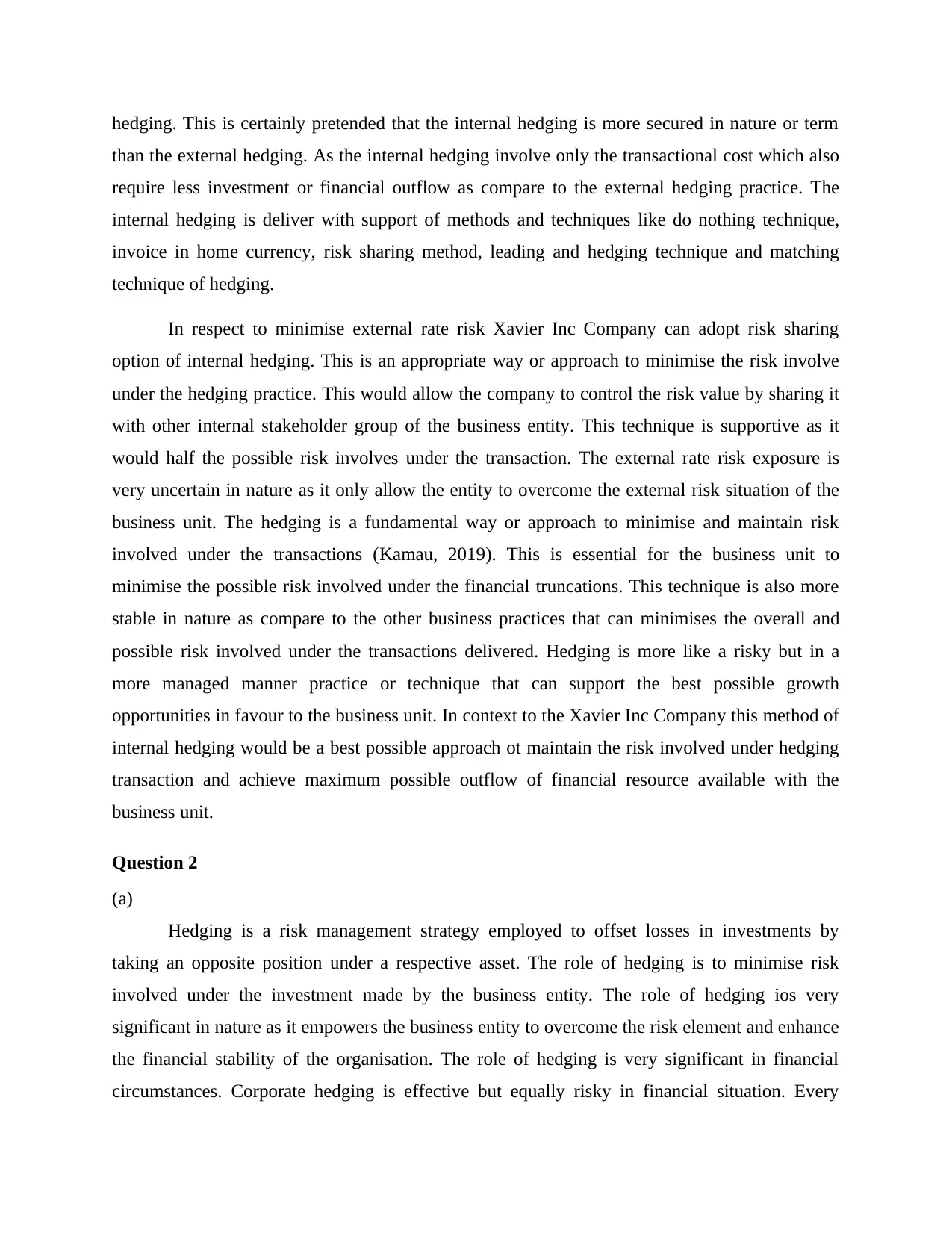
hedging. This is certainly pretended that the internal hedging is more secured in nature or term
than the external hedging. As the internal hedging involve only the transactional cost which also
require less investment or financial outflow as compare to the external hedging practice. The
internal hedging is deliver with support of methods and techniques like do nothing technique,
invoice in home currency, risk sharing method, leading and hedging technique and matching
technique of hedging.
In respect to minimise external rate risk Xavier Inc Company can adopt risk sharing
option of internal hedging. This is an appropriate way or approach to minimise the risk involve
under the hedging practice. This would allow the company to control the risk value by sharing it
with other internal stakeholder group of the business entity. This technique is supportive as it
would half the possible risk involves under the transaction. The external rate risk exposure is
very uncertain in nature as it only allow the entity to overcome the external risk situation of the
business unit. The hedging is a fundamental way or approach to minimise and maintain risk
involved under the transactions (Kamau, 2019). This is essential for the business unit to
minimise the possible risk involved under the financial truncations. This technique is also more
stable in nature as compare to the other business practices that can minimises the overall and
possible risk involved under the transactions delivered. Hedging is more like a risky but in a
more managed manner practice or technique that can support the best possible growth
opportunities in favour to the business unit. In context to the Xavier Inc Company this method of
internal hedging would be a best possible approach ot maintain the risk involved under hedging
transaction and achieve maximum possible outflow of financial resource available with the
business unit.
Question 2
(a)
Hedging is a risk management strategy employed to offset losses in investments by
taking an opposite position under a respective asset. The role of hedging is to minimise risk
involved under the investment made by the business entity. The role of hedging ios very
significant in nature as it empowers the business entity to overcome the risk element and enhance
the financial stability of the organisation. The role of hedging is very significant in financial
circumstances. Corporate hedging is effective but equally risky in financial situation. Every
than the external hedging. As the internal hedging involve only the transactional cost which also
require less investment or financial outflow as compare to the external hedging practice. The
internal hedging is deliver with support of methods and techniques like do nothing technique,
invoice in home currency, risk sharing method, leading and hedging technique and matching
technique of hedging.
In respect to minimise external rate risk Xavier Inc Company can adopt risk sharing
option of internal hedging. This is an appropriate way or approach to minimise the risk involve
under the hedging practice. This would allow the company to control the risk value by sharing it
with other internal stakeholder group of the business entity. This technique is supportive as it
would half the possible risk involves under the transaction. The external rate risk exposure is
very uncertain in nature as it only allow the entity to overcome the external risk situation of the
business unit. The hedging is a fundamental way or approach to minimise and maintain risk
involved under the transactions (Kamau, 2019). This is essential for the business unit to
minimise the possible risk involved under the financial truncations. This technique is also more
stable in nature as compare to the other business practices that can minimises the overall and
possible risk involved under the transactions delivered. Hedging is more like a risky but in a
more managed manner practice or technique that can support the best possible growth
opportunities in favour to the business unit. In context to the Xavier Inc Company this method of
internal hedging would be a best possible approach ot maintain the risk involved under hedging
transaction and achieve maximum possible outflow of financial resource available with the
business unit.
Question 2
(a)
Hedging is a risk management strategy employed to offset losses in investments by
taking an opposite position under a respective asset. The role of hedging is to minimise risk
involved under the investment made by the business entity. The role of hedging ios very
significant in nature as it empowers the business entity to overcome the risk element and enhance
the financial stability of the organisation. The role of hedging is very significant in financial
circumstances. Corporate hedging is effective but equally risky in financial situation. Every
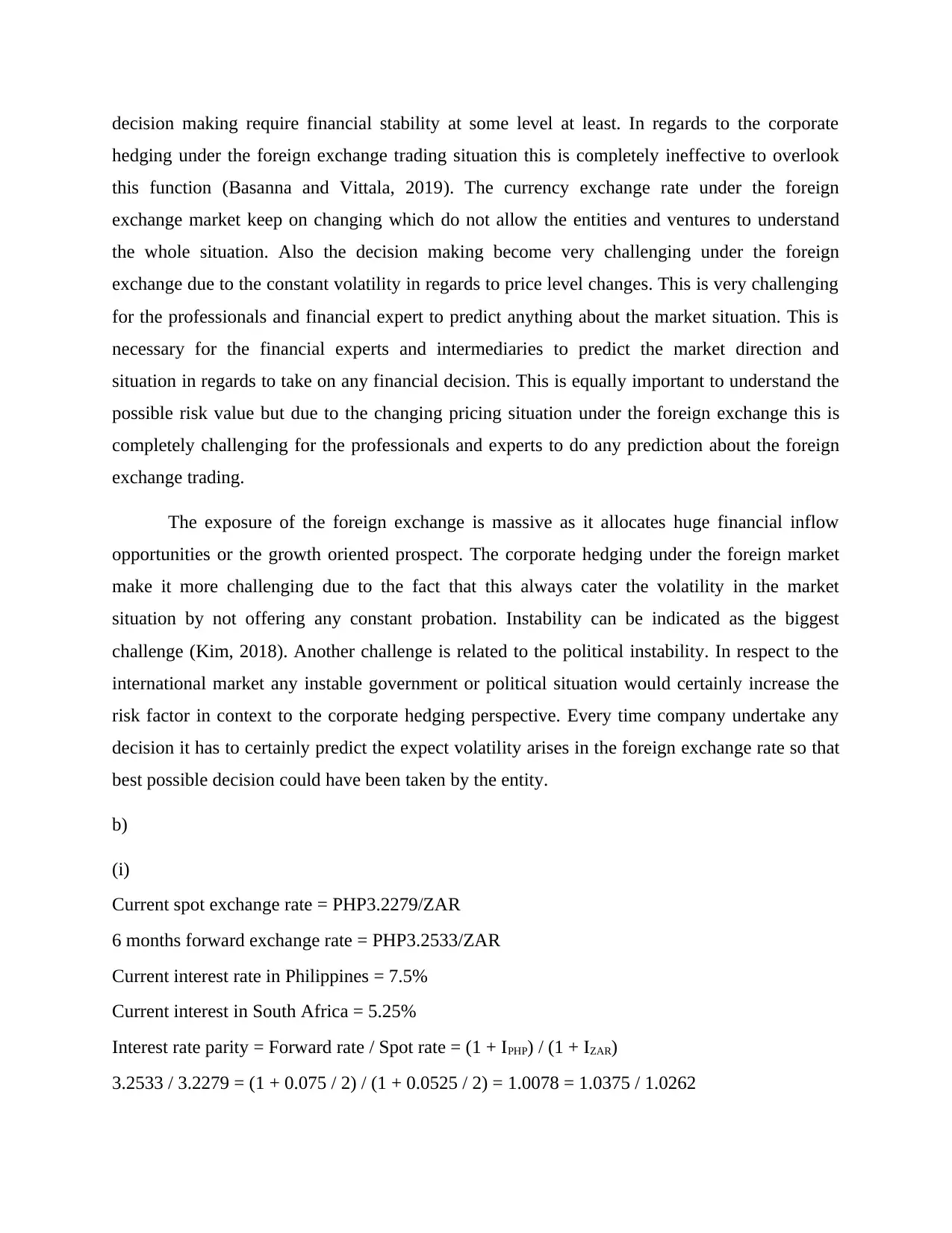
decision making require financial stability at some level at least. In regards to the corporate
hedging under the foreign exchange trading situation this is completely ineffective to overlook
this function (Basanna and Vittala, 2019). The currency exchange rate under the foreign
exchange market keep on changing which do not allow the entities and ventures to understand
the whole situation. Also the decision making become very challenging under the foreign
exchange due to the constant volatility in regards to price level changes. This is very challenging
for the professionals and financial expert to predict anything about the market situation. This is
necessary for the financial experts and intermediaries to predict the market direction and
situation in regards to take on any financial decision. This is equally important to understand the
possible risk value but due to the changing pricing situation under the foreign exchange this is
completely challenging for the professionals and experts to do any prediction about the foreign
exchange trading.
The exposure of the foreign exchange is massive as it allocates huge financial inflow
opportunities or the growth oriented prospect. The corporate hedging under the foreign market
make it more challenging due to the fact that this always cater the volatility in the market
situation by not offering any constant probation. Instability can be indicated as the biggest
challenge (Kim, 2018). Another challenge is related to the political instability. In respect to the
international market any instable government or political situation would certainly increase the
risk factor in context to the corporate hedging perspective. Every time company undertake any
decision it has to certainly predict the expect volatility arises in the foreign exchange rate so that
best possible decision could have been taken by the entity.
b)
(i)
Current spot exchange rate = PHP3.2279/ZAR
6 months forward exchange rate = PHP3.2533/ZAR
Current interest rate in Philippines = 7.5%
Current interest in South Africa = 5.25%
Interest rate parity = Forward rate / Spot rate = (1 + IPHP) / (1 + IZAR)
3.2533 / 3.2279 = (1 + 0.075 / 2) / (1 + 0.0525 / 2) = 1.0078 = 1.0375 / 1.0262
hedging under the foreign exchange trading situation this is completely ineffective to overlook
this function (Basanna and Vittala, 2019). The currency exchange rate under the foreign
exchange market keep on changing which do not allow the entities and ventures to understand
the whole situation. Also the decision making become very challenging under the foreign
exchange due to the constant volatility in regards to price level changes. This is very challenging
for the professionals and financial expert to predict anything about the market situation. This is
necessary for the financial experts and intermediaries to predict the market direction and
situation in regards to take on any financial decision. This is equally important to understand the
possible risk value but due to the changing pricing situation under the foreign exchange this is
completely challenging for the professionals and experts to do any prediction about the foreign
exchange trading.
The exposure of the foreign exchange is massive as it allocates huge financial inflow
opportunities or the growth oriented prospect. The corporate hedging under the foreign market
make it more challenging due to the fact that this always cater the volatility in the market
situation by not offering any constant probation. Instability can be indicated as the biggest
challenge (Kim, 2018). Another challenge is related to the political instability. In respect to the
international market any instable government or political situation would certainly increase the
risk factor in context to the corporate hedging perspective. Every time company undertake any
decision it has to certainly predict the expect volatility arises in the foreign exchange rate so that
best possible decision could have been taken by the entity.
b)
(i)
Current spot exchange rate = PHP3.2279/ZAR
6 months forward exchange rate = PHP3.2533/ZAR
Current interest rate in Philippines = 7.5%
Current interest in South Africa = 5.25%
Interest rate parity = Forward rate / Spot rate = (1 + IPHP) / (1 + IZAR)
3.2533 / 3.2279 = (1 + 0.075 / 2) / (1 + 0.0525 / 2) = 1.0078 = 1.0375 / 1.0262
⊘ This is a preview!⊘
Do you want full access?
Subscribe today to unlock all pages.

Trusted by 1+ million students worldwide
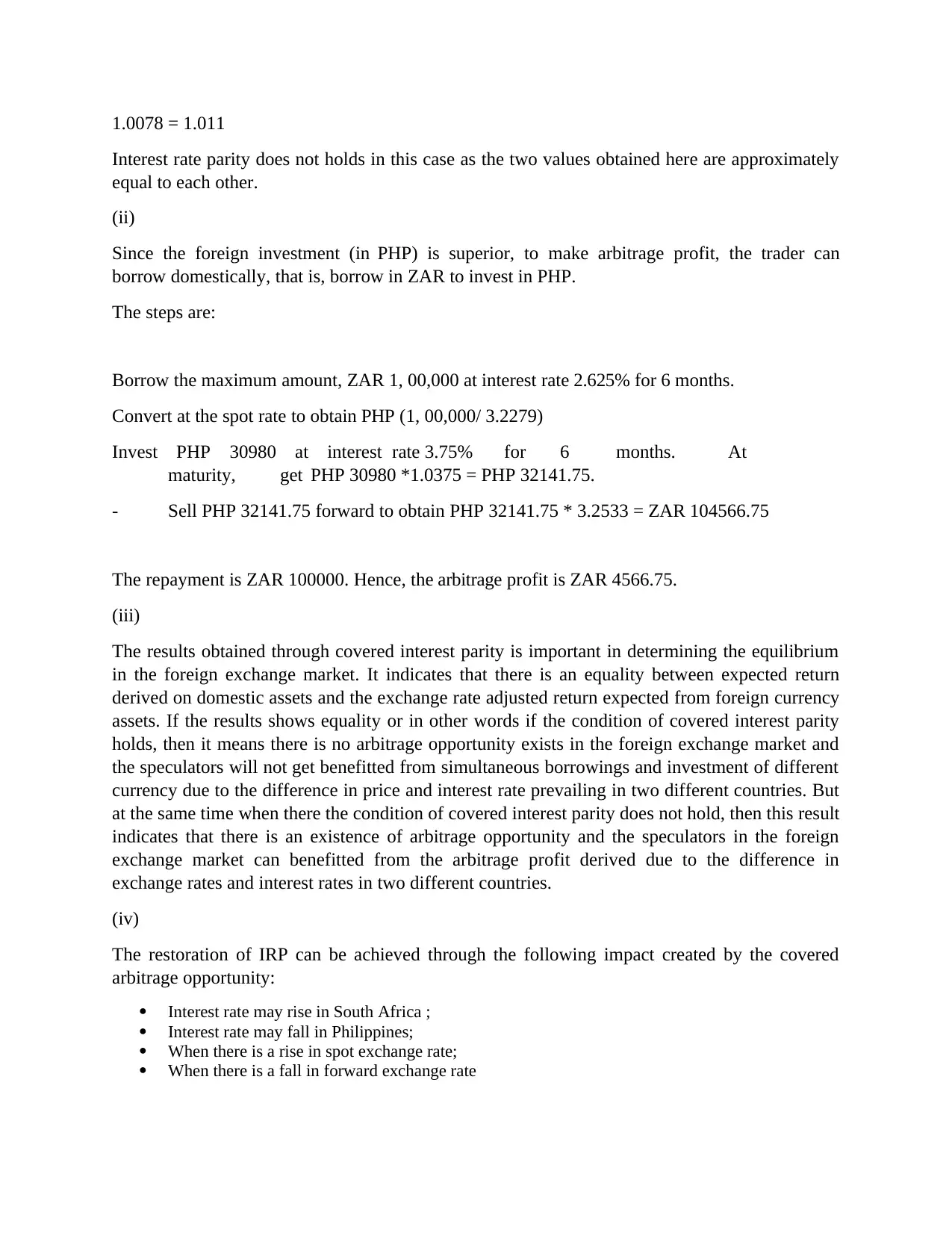
1.0078 = 1.011
Interest rate parity does not holds in this case as the two values obtained here are approximately
equal to each other.
(ii)
Since the foreign investment (in PHP) is superior, to make arbitrage profit, the trader can
borrow domestically, that is, borrow in ZAR to invest in PHP.
The steps are:
Borrow the maximum amount, ZAR 1, 00,000 at interest rate 2.625% for 6 months.
Convert at the spot rate to obtain PHP (1, 00,000/ 3.2279)
Invest PHP 30980 at interest rate 3.75% for 6 months. At
maturity, get PHP 30980 *1.0375 = PHP 32141.75.
- Sell PHP 32141.75 forward to obtain PHP 32141.75 * 3.2533 = ZAR 104566.75
The repayment is ZAR 100000. Hence, the arbitrage profit is ZAR 4566.75.
(iii)
The results obtained through covered interest parity is important in determining the equilibrium
in the foreign exchange market. It indicates that there is an equality between expected return
derived on domestic assets and the exchange rate adjusted return expected from foreign currency
assets. If the results shows equality or in other words if the condition of covered interest parity
holds, then it means there is no arbitrage opportunity exists in the foreign exchange market and
the speculators will not get benefitted from simultaneous borrowings and investment of different
currency due to the difference in price and interest rate prevailing in two different countries. But
at the same time when there the condition of covered interest parity does not hold, then this result
indicates that there is an existence of arbitrage opportunity and the speculators in the foreign
exchange market can benefitted from the arbitrage profit derived due to the difference in
exchange rates and interest rates in two different countries.
(iv)
The restoration of IRP can be achieved through the following impact created by the covered
arbitrage opportunity:
Interest rate may rise in South Africa ;
Interest rate may fall in Philippines;
When there is a rise in spot exchange rate;
When there is a fall in forward exchange rate
Interest rate parity does not holds in this case as the two values obtained here are approximately
equal to each other.
(ii)
Since the foreign investment (in PHP) is superior, to make arbitrage profit, the trader can
borrow domestically, that is, borrow in ZAR to invest in PHP.
The steps are:
Borrow the maximum amount, ZAR 1, 00,000 at interest rate 2.625% for 6 months.
Convert at the spot rate to obtain PHP (1, 00,000/ 3.2279)
Invest PHP 30980 at interest rate 3.75% for 6 months. At
maturity, get PHP 30980 *1.0375 = PHP 32141.75.
- Sell PHP 32141.75 forward to obtain PHP 32141.75 * 3.2533 = ZAR 104566.75
The repayment is ZAR 100000. Hence, the arbitrage profit is ZAR 4566.75.
(iii)
The results obtained through covered interest parity is important in determining the equilibrium
in the foreign exchange market. It indicates that there is an equality between expected return
derived on domestic assets and the exchange rate adjusted return expected from foreign currency
assets. If the results shows equality or in other words if the condition of covered interest parity
holds, then it means there is no arbitrage opportunity exists in the foreign exchange market and
the speculators will not get benefitted from simultaneous borrowings and investment of different
currency due to the difference in price and interest rate prevailing in two different countries. But
at the same time when there the condition of covered interest parity does not hold, then this result
indicates that there is an existence of arbitrage opportunity and the speculators in the foreign
exchange market can benefitted from the arbitrage profit derived due to the difference in
exchange rates and interest rates in two different countries.
(iv)
The restoration of IRP can be achieved through the following impact created by the covered
arbitrage opportunity:
Interest rate may rise in South Africa ;
Interest rate may fall in Philippines;
When there is a rise in spot exchange rate;
When there is a fall in forward exchange rate
Paraphrase This Document
Need a fresh take? Get an instant paraphrase of this document with our AI Paraphraser
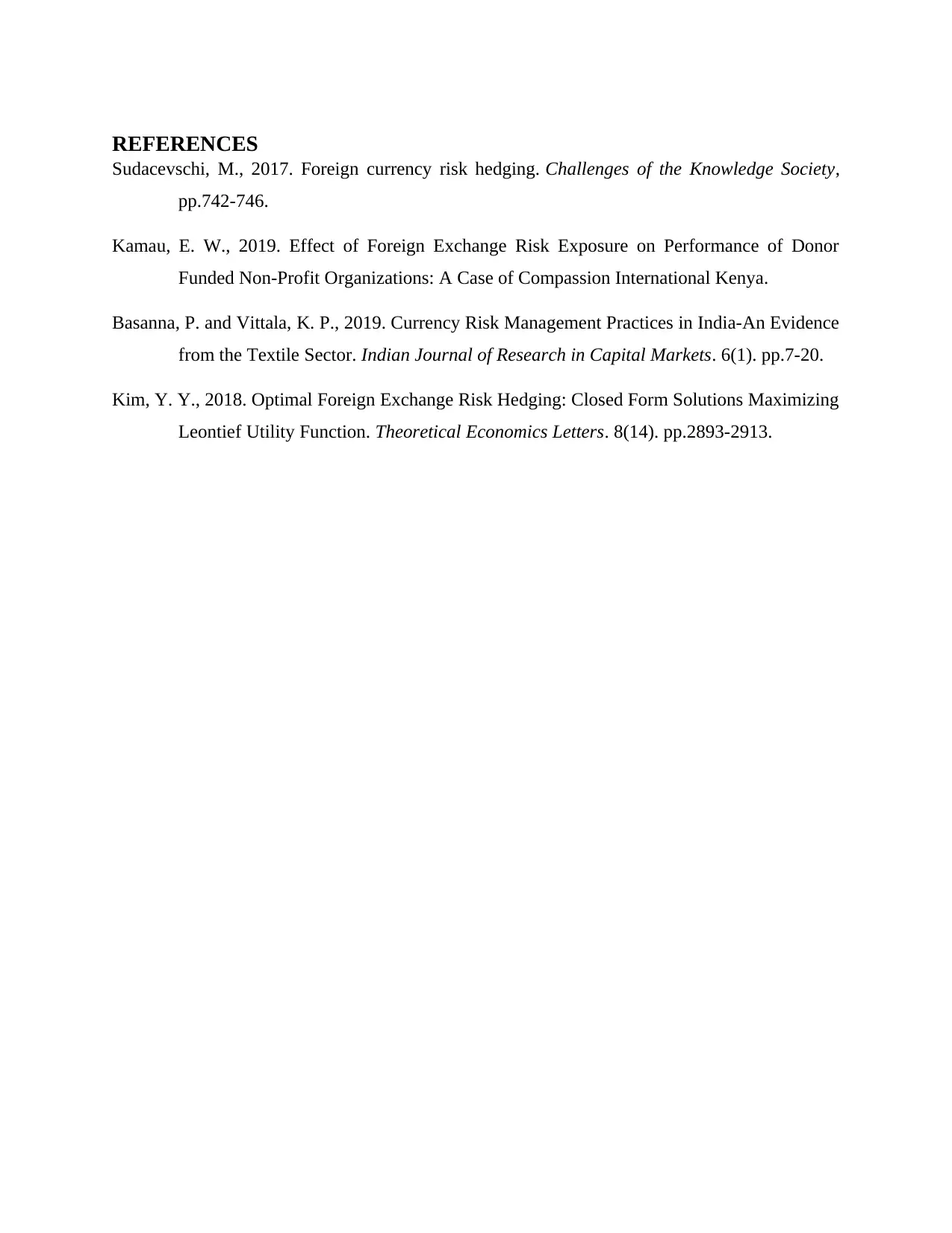
REFERENCES
Sudacevschi, M., 2017. Foreign currency risk hedging. Challenges of the Knowledge Society,
pp.742-746.
Kamau, E. W., 2019. Effect of Foreign Exchange Risk Exposure on Performance of Donor
Funded Non-Profit Organizations: A Case of Compassion International Kenya.
Basanna, P. and Vittala, K. P., 2019. Currency Risk Management Practices in India-An Evidence
from the Textile Sector. Indian Journal of Research in Capital Markets. 6(1). pp.7-20.
Kim, Y. Y., 2018. Optimal Foreign Exchange Risk Hedging: Closed Form Solutions Maximizing
Leontief Utility Function. Theoretical Economics Letters. 8(14). pp.2893-2913.
Sudacevschi, M., 2017. Foreign currency risk hedging. Challenges of the Knowledge Society,
pp.742-746.
Kamau, E. W., 2019. Effect of Foreign Exchange Risk Exposure on Performance of Donor
Funded Non-Profit Organizations: A Case of Compassion International Kenya.
Basanna, P. and Vittala, K. P., 2019. Currency Risk Management Practices in India-An Evidence
from the Textile Sector. Indian Journal of Research in Capital Markets. 6(1). pp.7-20.
Kim, Y. Y., 2018. Optimal Foreign Exchange Risk Hedging: Closed Form Solutions Maximizing
Leontief Utility Function. Theoretical Economics Letters. 8(14). pp.2893-2913.
1 out of 8
Related Documents
Your All-in-One AI-Powered Toolkit for Academic Success.
+13062052269
info@desklib.com
Available 24*7 on WhatsApp / Email
![[object Object]](/_next/static/media/star-bottom.7253800d.svg)
Unlock your academic potential
Copyright © 2020–2025 A2Z Services. All Rights Reserved. Developed and managed by ZUCOL.





